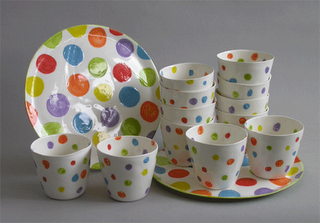 We received two big boxes of work from Mary Anne Davis (Davistudio) yesterday! Mary Anne took these pictures for her wonderful kiln-opening blog, and I've borrowed them to show you here. Most of the fabulous pieces shown are now available at Greenjeans -- come in and check 'em out!
We received two big boxes of work from Mary Anne Davis (Davistudio) yesterday! Mary Anne took these pictures for her wonderful kiln-opening blog, and I've borrowed them to show you here. Most of the fabulous pieces shown are now available at Greenjeans -- come in and check 'em out!* * *
Toward a Phenomenology of the Handmade
In grad school, I studied Heideggerian (or existential) phenomenology with Tom de Zengotita. I wrote about “barnness” for my thesis, trying to understand philosophically why people care to save old barns in NH. Since opening Greenjeans, I’ve wanted to explore a phenomenology of the handmade. This interest relates to my curiosity about the overlapping realms of art, craft, and design, which I began exploring in this earlier blog entry. Today the investigation continues…
It's always exciting to open boxes of new work, but often times it's really a very special experience because each and every piece is possessed of a very unique liveliness. This may sound overblown (especially since pictures gloss the work's tacticity), but if you've ever handled something skillfully handmade before you'll have an idea of what I'm talking about.
 Mary Anne Davis' work is vividly imbued with this quality. When I unwrap a piece of her pottery it's like meeting a new person or seeing a new species of plant up close for the first time. I might know that what will be inside a curl of bubblewrap is a blue seed vase, but once that veil is removed the object shows me its particular interpretation of what it is to be a seed vase, revealing itself as the individual being that it is. This is part of what makes handmade work so incredibly different from machine-made items.
Mary Anne Davis' work is vividly imbued with this quality. When I unwrap a piece of her pottery it's like meeting a new person or seeing a new species of plant up close for the first time. I might know that what will be inside a curl of bubblewrap is a blue seed vase, but once that veil is removed the object shows me its particular interpretation of what it is to be a seed vase, revealing itself as the individual being that it is. This is part of what makes handmade work so incredibly different from machine-made items.What do I mean by this? Well, like people, each of Mary Anne's pieces has its own particular quirks and characteristics. Some are perfectly formed and evenly glazed and unblemished. But those are the minority. Most pieces have a little something about them that makes them unique and lively: maybe the glaze runs thin along one side of a vase, maybe the mouth of an udon bowl is slightly oblong causing it to nest askew (though not uncomfortably) when stacked, maybe there are a few white pinpoints down the side of a juice cup where some air bubbles escaped. These are birthmarks that needn't be considered errors; on the contrary, they speak to the snowflake pattern of the soul. Mary Anne makes space for them, allowing each work to be its imperfect self, in keeping with the Japanese philosophy of wabi-sabi. If a crack emerges during firing, or a handle sits too low making a mug dangerously unstable, the fish gets thrown back in the pond since these traits impair the physical integrity and usefulness of the work and do not just automatically get covered by the philosophy of beauty-in-imperfection. But most of the time what emerges from the kiln is sound and saleable.
 In the same way as when we deal with people, when we use these dishes we accommodate their unique set of quirks in order to have a good relationship with them. And in fact it is these quirks that make the dishes, like people, intriguing, different, beautiful, and even loveable. It is no wonder that Mary Anne is also involved in peace activism.
In the same way as when we deal with people, when we use these dishes we accommodate their unique set of quirks in order to have a good relationship with them. And in fact it is these quirks that make the dishes, like people, intriguing, different, beautiful, and even loveable. It is no wonder that Mary Anne is also involved in peace activism.Mary Anne's pottery is more than just functional craft. It also enters the realm of art by the way each work negotiates the line between imperfection and defection (as described above), and by the way each work engages our curiosity and care. Speaking to this second point, when I handle her dishes at the shop or the ones I live with at home, I am always distinctly aware of them. They are never just objects, they are always calling my attention to them with the special way they feel, their colors and patterns, and their unique birthmarks. I know they are fragile (though not as eggshell-fragile as they may seem), and so I handle them carefully. I enjoy how the work invites this mindfulness, and am often amazed at how spiritual a little porcelain bowl or cup can be.
The machine-made dishes I also use at home, no matter how well designed, certainly do not effect me this way…
Technorati tags:
Davistudio
Handmade
Slipcast Porcelain
Phenomenology
Davistudio
Handmade
Slipcast Porcelain
Phenomenology






1 comment:
Wow. That is the loveliest writing ever done about my work. Thank you, Amy. You've taken my breath away--
Post a Comment